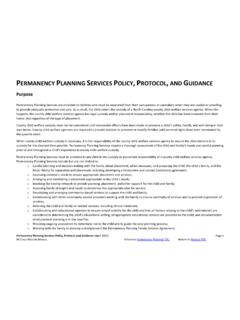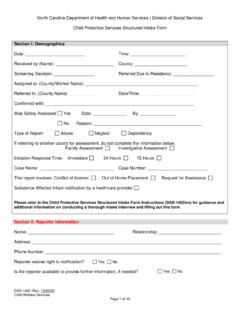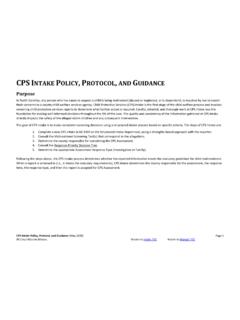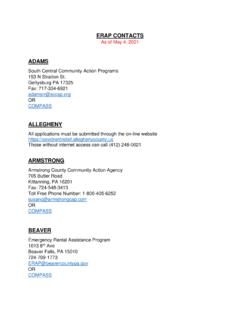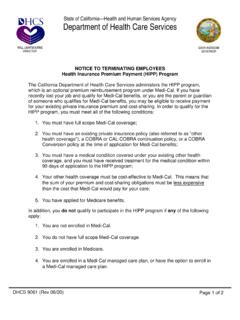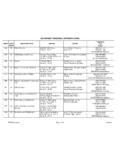Transcription of North Carolina Department of Health and Human Services ...
1 North Carolina Department of Health and Human Services Division of Medical Assistance Medicaid Eligibility Unit FAMILY AND CHILDREN S MEDICAID MANUAL MA-3305 MAF, MIC, HSF BUDGETING 1 MA-3305 MAF, MIC, HSF BUDGETING REISSUED 07/01/10 CHANGE NO. 08-10 I. INTRODUCTION This section contains budgeting instructions for MAF, MIC and HSF, including rules for when to compute a deductible and when to evaluate eligibility. Instructions for MPW are contained in MA-3310, MPW Budgeting. To determine eligibility for Medicaid: A. Identify all the person(s) in the home for whom assistance is requested. This is the assistance unit. B. Identify whose income to count in the budgeting process. The members of the assistance unit plus these identified individuals constitute the budget unit. C. Identify children in the home under 21 who are not in the assistance unit but must be considered in determining the correct income limit to use in determining eligibility because their parents are in the budget unit.
2 The needs unit is comprised of members of the budget unit plus these children. D. Identify the correct income limits (based on needs unit) and resource limits (based on budget unit) to use in determining eligibility. E. Re-evaluate eligibility if any members of the original assistance unit are ineligible or have a deductible. This may mean establishing more than one assistance unit and/or evaluating under other Medicaid coverage groups. II. POLICY RULES When determining eligibility for MAF, MIC-N, MIC-1, or HSF, compare countable income to the appropriate income limit or age limit (if MIC) in the aid/program category under which eligibility is being evaluated. For those eligible under Expanded Foster Care Program, do not count income or assets in determining eligibility. A. Evaluate for MAF coverage first if the parents or other adults are requesting assistance. If income is above the allowable limit, the assistance unit is ineligible for Categorically Needy coverage. The applicant(s) may qualify for MAF with a deductible if otherwise eligible for Medically Needy coverage.
3 North Carolina Department of Health and Human Services FAMILY AND CHILDREN S MEDICAID MANUAL MA-3305 MAF, MIC, HSF BUDGETING 2 REVISED 07/01/10 CHANGE NO. 08-10 (II.) B. Evaluate for MIC-N coverage if the assistance unit is ineligible for MAF coverage. When evaluating the applicant for MIC-N coverage for himself or others if a child s income causes ineligibility, evaluate using separate assistance units. C. Evaluate for MIC-1 coverage for children age birth to age one if the assistance unit is ineligible for MIC-N due to countable income exceeding 185% of fpl and the countable income is less than or equal to 200% fpl. D. Evaluate for MIC-1 coverage for children age one through five if the assistance unit is ineligible for MIC-N due to countable income exceeding 133% of fpl and the countable income is less than or equal to 200% fpl. E. Evaluate for HSF those children who receive State Foster Home Funds, are in the custody of the county dss, or for whom the dss has placement responsibility.
4 F. MAF, MIC, and HSF Categorically Needy (Classification C, Categorically Needy, Classification 1, Categorically Needy and Classification N, Categorically Needy No Money Payment) MAF may have a categorically needy classification of C or N. MIC may have a categorically needy classification of N or 1. HSF may have a categorically needy classification of N. Refer to MA-3415, Classification and Evaluation. Classify non-qualified aliens that would otherwise be eligible for Medicaid under MIC-1 with the appropriate Medicaid alien codes. Qualified and non-qualified aliens (See MA-3330, Alien Requirements) have special classification codes so see EIS 4000, Codes Appendix. NOTE: HSF-C is for HSF children who receive SSI. Their eligibility is not determined following the policy in this section. Refer to the Aged, Blind, and Disabled Medicaid Manual. For MAF-C or N, MIC-N or 1 and HSF-N 1. An assistance unit must have countable monthly income equal to or less than the CN Income Limit for the number in the needs unit.
5 2. For MAF C or N resources must not exceed the resource limit. 3. There can be no deductible in Categorically Needy coverage. North Carolina Department of Health and Human Services FAMILY AND CHILDREN S MEDICAID MANUAL MA-3305 MAF, MIC, HSF BUDGETING 3 REVISED 07/01/10 CHANGE NO. 08-10 ( ) 4. Once eligibility is established for MIC-N and/or MIC-1, MAF-C or N, or HSF-N, eligibility continues for 12 months for children up to age 19 and under without regard to changes in assets or income or household composition. Refer to for exceptions to continuous eligibility. The 12 month continuous period begins with the first month of the ongoing certification period. G. Expanded Foster Care Program (EFCP) Eligibility coverage requirements for IAS and HSF adolescents ages 18, 19, and 20 in the Expanded Foster Care Program (EFCP) are: 1. Were in foster care on their 18th birthday. 2. Continues to be a resident of North Carolina . 3. Must not be receiving Medicaid from another county or state.
6 4. Must not be an inmate of a public institution. 5. Must furnish their social security number, provide third party information, and apply for all benefits to which they may be entitled. See MA-3230, Eligibility of Individuals Under Age 21, for policy on the Expanded Foster Care Program. H. MAF M and HSF M (Medically Needy) Classification Code - M Qualified and non-qualified aliens (See MA-3330, Alien Requirements) have special classification codes. See EIS 4000, Codes Appendix. 1. An assistance unit that is ineligible as categorically needy and children ineligible for NC Health Choice due to excess income may be eligible for MN coverage. 2. If the income of the needs unit exceeds the Medically Needy Income Limit, the assistance unit is eligible when it meets a deductible for the certification period and resources are within allowable limits. 3. Once an HSF-M child reaches age 18, do not count assets or income of the HSF child. Continue this exclusion through the month he turns age 21.
7 North Carolina Department of Health and Human Services FAMILY AND CHILDREN S MEDICAID MANUAL MA-3305 MAF, MIC, HSF BUDGETING 4 REISSUED 07/01/10 CHANGE NO. 08-10 III. FINANCIAL RESPONSIBILITY Count the income of individuals who are financially responsible for the applicant(s). A. Spouse for Spouse 1. Except as stated in 2. count a spouse s income as available to the spouse who is applying for or receiving Medicaid when: a. They live together, or b. One is temporarily absent for 12 months or less, including temporary absence in long-term care. 2. Do not count the income of a spouse who receives SSI, Work First or CAP, and do not include them in the budget unit or needs unit. B. Parent for Child 1. Except as stated below, count the income of the parent(s) including a putative father, regardless of the parent(s) age, as available to an individual under age 21 who: a. Lives in the home of his parent(s) or is temporarily absent (see C., below.), and b. Lives outside of the home and is a student, unless evidence is presented to establish that the student is not financially dependent upon his parent(s) and has assumed total responsibility for his own support and care.
8 (See C. below) 2. Exceptions to parental financial responsibility a. Do not count the income of a parent who receives SSI, Work First or CAP. b. Do not count the income of the putative father of an unborn child in any program category/coverage group. c. Do not count parent s income to an individual under age 21 who: (1) Is or has been legally married. (2) Lives outside the parent(s) home in excess of 12 months or intends to be outside of the home on a permanent basis. (3) Is budgeted under long-term care policy because he will be out of the home in a Medicaid certified medical institution in excess of 12 months. Refer to MA-3325, Long Term Care Budgeting, for instructions for verifying type of treatment and length of stay. North Carolina Department of Health and Human Services FAMILY AND CHILDREN S MEDICAID MANUAL MA-3305 MAF, MIC, HSF BUDGETING 5 REVISED 10/01/07 CHANGE NO. 16-07 ( ) (4) Has served in or is currently in the military. (5) Has been legally emancipated.
9 (6) Is applying for FPW benefits. Parental financial responsibility does not apply in FPW. d. Is in custody of the county Department of social Services , or for whom the county agency has court-ordered placement responsibility, regardless of where the child is placed ( temporary placement in the home while custody is retained by the dss). Financial responsibility on the part of the parents ceases beginning with the month in which the county assumes custody. e. Is eligible for Title IV-E adoption/foster care assistance, receives State Foster Home Funds or is evaluated as an adoptive child with special needs. Do not count the assets or income of the IAS child from age 18 through the month he turns age 21. (1) HSF and IAS coverage for county custody and Title IV-E begins the month the county actually takes responsibility or the child is released by the parent(s) for adoption. (2) Evaluate retroactive coverage under the aid program/category appropriate to the child s situation during the retroactive months.
10 Do not count the assets or income in the retroactive months of the IAS child from age 18 through the month he turns age 21. Retroactive months cannot be prior to October 1, 2007, for EFCP. NOTE: Follow instructions in MA-3365, Child Support, for referring a foster child to Child Support Enforcement. f. Is a newborn child who does not go home from the hospital with the parent(s) and they are never his caretaker and/or do not intend to provide a home for him. (This includes any retroactive or ongoing period of eligibility). North Carolina Department of Health and Human Services FAMILY AND CHILDREN S MEDICAID MANUAL MA-3305 MAF, MIC, HSF BUDGETING 6 REISSUED 10/01/07 CHANGE NO. 16-07 (III.) 3. Joint Custody a. When a child's parents live apart but have joint custody, determine which parent is the primary caretaker. This is the parent with whom the child spends the majority of his time, the parent who is primarily responsible for the child's day-to-day care (school, day care, medical care).


